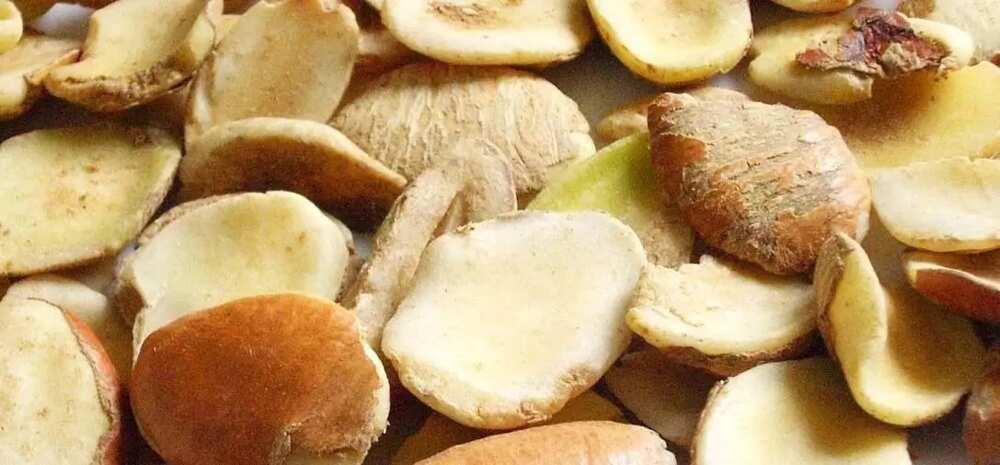Ogbono
₦15,000.00 – ₦90,000.00
Ogbono, also known as wild mango or African mango, comes from the Irvingia gabonensis tree, native to West Africa. These seeds are valued in cuisine for their thickening properties and nutty flavor, often used in ogbono soup. Rich in healthy fats, fiber, and minerals, ogbono supports weight management, cholesterol levels, and digestive health. To use, ground the dried seeds into powder for soups and stews. Store in an airtight container in a cool, dry place to preserve freshness. Enjoy its unique taste and health benefits!
Description
Ogbono, also known as wild mango, African mango, or bush mango, refers to the seeds of the Irvingia gabonensis tree. These seeds are highly valued in West African cuisine, particularly for their unique thickening properties and rich, nutty flavor. Ogbono seeds are typically ground into a powder and used to prepare various traditional dishes, most notably ogbono soup.
Botanical Description
- Scientific Name: Irvingia gabonensis
- Family: Irvingiaceae
- Common Names: Ogbono, bush mango, dika nut, wild mango, African mango
- Plant Description:
- Tree: A large, deciduous tree that can grow up to 40 meters (130 feet) tall with a dense, broad crown.
- Leaves: Broad, dark green, and elliptical.
- Flowers: Small, greenish-yellow clusters.
- Fruit: Resembles a mango, with a fibrous pulp and a large, hard seed inside.
Physical Characteristics of Ogbono Seeds
- Size and Shape: Flattened, disk-like seeds about 2-4 cm in diameter.
- Color: Light brown or grayish when dried.
- Texture: Hard exterior with a slightly oily interior when ground.
- Aroma: Mildly nutty and earthy when ground.
- Flavor: Rich, nutty flavor with a hint of bitterness.
Nutritional Profile (per 100 grams)
- Calories: Approximately 605 kcal
- Carbohydrates: Around 15 grams
- Protein: About 8 grams
- Fat: Roughly 55 grams, predominantly healthy fats
- Fiber: Approximately 4 grams
- Vitamins and Minerals: Rich in calcium, magnesium, potassium, iron, and vitamins A, B1 (thiamine), and B2 (riboflavin).
Health Benefits
- Weight Management: Believed to help in weight management by reducing appetite and improving metabolic function.
- Cholesterol Levels: Contains compounds that may help lower bad cholesterol (LDL) levels and increase good cholesterol (HDL) levels.
- Digestive Health: High fiber content aids in digestion and promotes a healthy gut.
- Antioxidant Properties: Contains antioxidants that help protect the body from oxidative stress.
- Anti-inflammatory: Exhibits anti-inflammatory properties that can help reduce inflammation.
- Blood Sugar Control: May help in regulating blood sugar levels, making it beneficial for diabetics.
Culinary Uses
- Thickening Agent: Used primarily as a thickening agent in soups and stews due to its mucilaginous properties.
- Traditional Dishes: A key ingredient in ogbono soup, a popular Nigerian dish often made with vegetables, meat, fish, and seasonings.
- Flavor Enhancer: Adds a unique nutty flavor to dishes, complementing other ingredients.
- Snacks: Roasted or ground ogbono seeds can be eaten as a snack.
Traditional Recipes
- Ogbono Soup: Made with ground ogbono seeds, leafy greens (such as bitter leaf or spinach), assorted meats (such as goat, beef, or chicken), fish, and various seasonings. It is often served with fufu, pounded yam, or rice.
- Ogbono Stew: Similar to ogbono soup but with a thicker consistency, often incorporating tomatoes and additional spices.
Preparation
- Harvesting: The fruit is harvested when mature and the seeds are extracted from the pulp.
- Cleaning: Seeds are cleaned to remove any remaining pulp and debris.
- Drying: Cleaned seeds are sun-dried or dried mechanically until they are hard.
- Grinding: Dried seeds are ground into a fine powder, ready for use in cooking.
Storage
- Conditions: Store in an airtight container in a cool, dry place to prevent rancidity.
- Shelf Life: Ground ogbono can last for several months if stored properly. Whole seeds have a longer shelf life.
Cultural and Historical Significance
- Culinary Staple: An essential ingredient in many West African households, especially in Nigeria, Ghana, and Cameroon.
- Traditional Medicine: Used in traditional medicine for its purported health benefits, including weight management and cholesterol control.
Safety and Precautions
- Allergies: Individuals with seed or nut allergies should consume ogbono with caution.
- Storage: Proper storage is crucial to prevent the seeds from becoming rancid.
Additional information
| Weight | N/A |
|---|---|
| Package Size | 500g, 1kg, 2kg, 3kg |


Reviews
There are no reviews yet.